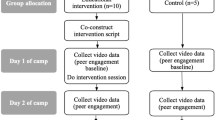Abstract
This article reports on a multi-method impact evaluation of a therapeutic summer camp program for children and youth with learning disabilities and related psychosocial problems. The study examines the degree to which program objectives were achieved through a pre-camp, post-camp, follow-up design using a series of standardized instruments, camp evaluations, and interviews with parents. The results indicate that the campers reported less social isolation, experienced modest improvements in self-esteem, and expressed high levels of satisfaction with the camp. The measures for social skills generally failed to register significant changes, although parents reported improvements in the areas of cooperation, responsibility, and self-control.
Similar content being viewed by others
References
Asher, S. R., & Wheeler, V. A. (1985). Children's loneliness: A comparison of rejected and neglected peer status. Journal of Consulting and Clinical Psychology 53, 500–505.
Berkovitz, I. H., & Sugar, M. (1986). Indications and contraindications for adolescent group psychotherapy. In M. Sugar (Ed.), The adolescent in group and family therapy (pp. 3–26). Chicago: The University of Chicago Press.
Blake, J. (1996). Opening doors: Integration of persons with a disability in organized children's camping in Canada. Journal of Leisurability 23(2), 3–10.
Breton, M. (1990). Learning from social group work traditions. Social Work with Groups 13(3), 21–34.
Brown, L., & Alexander, J. (1991). Self-Esteem Index. PRO-ED, Inc.
Byers, E. S. (1979). Wilderness camping as a therapy for emotionally disturbed children: A critical review. Exceptional Children 45(8), 628–635.
Davis-Berman, J., & Berman, D. S. (1989). The wilderness therapy program: An empirical study of its effects with adolescents in an outpatient setting. Journal of Contemporary Psychotherapy 19(4), 271–281.
Gentry, M. E. (1984). Developments in activity analysis: Recreation and group work revisited. Social Work with Groups 7(1), 35–44.
Gresham, F., & Elliott, S. N. (1990). Social Skills Rating System Manual. New York: American Guidance Service, Inc.
Kelk, N. (1994). Camping and outdoor activities as psychosocial interventions. Australian Social Work 47(2), 37–42.
Kiewa, J. (1994). Self-control: The key to adventure? Towards a model of the adventure experience. Women and Therapy 15(3/4), 29–41.
Langdon, P., & Kelk, N. (1994). The paediatric AIDS camp: Three years of good times. Australian Social Work 47(3), 43–49.
Levitt, L. (1994). What is the therapeutic value of camping for emotionally disturbed girls? Women and Therapy 15(3/4), 129–137.
Marx, J. D. (1988). An outdoor adventure counseling program for adolescents. Social Work 33, 517–520.
Redl, F. (1966). Psychopathological risks of camp life. In When we deal with children: Selected writings (pp. 440–451). New York: The Free Press.
Schwartz, W. (1960). Characteristics of the group experience in residential camping. In T. Berman-Rossi (Ed.), Social work: The collected writings of William Schwartz (pp. 427–433). Itasca, Ill.: F. E. Peacock Publishers.
Shasby, G., Heuchert, C., & Gansneder, B. (1984). The effects of a structured camp experience on locus of control and self concept of special populations. Therapeutic Recreation Journal 18(2), 32–40.
Tassé, P. (1978). 'Roughing it' therapy. JOURNAL, Ontario Association of Children's Aid Societies 7, September, 1–3.
Vinter, R. D. (1965). Social group work. In H. L. Lurie (Ed.), Encyclopedia of Social Work (pp. 715–723). New York: National Association of Social Workers.
Wetzel, M. C., McNaboe, C., & McNaboe, K. A. (1995). A mission based ecological evaluation of a summer camp for youth with developmental disabilities. Evaluation and Program Planning 18(1), 37–46.
Author information
Authors and Affiliations
Rights and permissions
About this article
Cite this article
Michalski, J.H., Mishna, F., Worthington, C. et al. A Multi-Method Impact Evaluation of a Therapeutic Summer Camp Program. Child and Adolescent Social Work Journal 20, 53–76 (2003). https://doi.org/10.1023/A:1021467503588
Issue Date:
DOI: https://doi.org/10.1023/A:1021467503588




